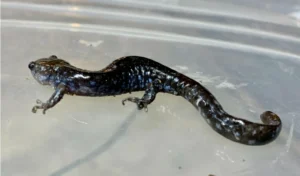If you keep pet salamanders, you’ve probably heard about pinkie mice as a feeder option. Pinkies are tiny, newborn mice without fur, often used as food for snakes, lizards, and some amphibians. But salamanders are different from many other pets. So, can they safely eat pinkie mice? And is it a good idea?
Yes, some large pet salamanders can eat pinkie mice, but it should be very rare and only an occasional treat, not a regular part of their diet. Pinkie mice are soft enough for big salamanders to swallow, but they aren’t the best food choice.
They’re high in fat, harder to digest than insects and worms, and can cause health problems if fed too often. Smaller salamanders simply can’t handle them.
What Are Pinkie Mice?
Pinkie mice are baby mice just a day or two old. They haven’t grown fur yet and are about the size of a jellybean. They’re soft, warm, and often sold frozen or live at pet stores.
Because of their softness and small size, pinkie mice are popular feeders for reptiles like snakes and large lizards. They provide a protein-rich meal without the tougher parts of adult mice.
But salamanders aren’t reptiles, and their feeding habits and digestive systems are different.
How Big Are Salamanders Compared to Pinkie Mice?
Size matters when it comes to feeding. The average salamander ranges from just a few inches to about a foot long, depending on the species. Pinkie mice are usually around 1 to 1.5 inches long.
For small salamanders under 6 inches, pinkie mice are too big to swallow safely. Even if they tried, they’d risk choking or hurting themselves.

Only the largest species, like tiger salamanders, have mouths big enough to handle pinkie mice.
Axolotls can sometimes eat them when fully grown, but smaller aquatic salamanders cannot.
Which Pet Salamanders Can Eat Pinkie Mice?
Here are the main species that might eat pinkie mice, usually when they reach a larger size:
1. Tiger Salamanders
They grow up to 12 inches or more. Their jaws are strong, and they eat large prey in the wild, sometimes small frogs or fish. Occasionally, owners feed them pinkie mice, but it’s rare and should be done carefully.
2. Axolotls
While smaller than tiger salamanders, big adult axolotls (9-12 inches) might eat pinkie mice occasionally. However, their diet mostly consists of worms, insects, and small aquatic animals.
3. Fire Salamanders
Some large fire salamanders might take pinkie mice, but this is rare. Most fire salamanders prefer insects and worms.
Why Are Pinkie Mice Not Ideal for Salamanders?
Even if a salamander can eat pinkie mice, there are several reasons to avoid making it a staple.
High Fat Content
Pinkie mice have more fat than the typical insects or worms salamanders eat.
Too much fat can lead to obesity and fatty liver disease, which are serious health problems.
Hard to Digest
Unlike soft-bodied insects and worms, pinkies have bones, fur, and other tough tissues.
Salamanders’ digestive systems aren’t designed to break these down easily. This can cause digestive blockages, or impaction.
Risk of Choking
If the pinkie mouse is too big or not bitten off in manageable pieces, a salamander can choke or injure its mouth.
Disease Risk
If the pinkie isn’t sourced or thawed properly, it can carry bacteria harmful to amphibians. Freezing helps kill some germs, but not all.
How Often Should You Feed Pinkie Mice?
If you decide to feed pinkie mice, keep it very occasional, no more than once a month.
Treat pinkies as a rare snack or supplement, not a regular meal. Most of the diet should be made up of safer, easier-to-digest prey like worms, crickets, and aquatic larvae.
Feeding pinkies too often risks:
- Digestive impaction
- Obesity
- Nutritional imbalance
- Stress and injury
How to Feed Pinkie Mice Safely to Salamanders
If you do feed pinkie mice, follow these safety tips:
- Buy from a trusted pet supplier to ensure quality.
- Use frozen thawed pinkies rather than live to avoid injury to your salamander.
- Thaw slowly in sealed bags inside warm water to avoid bacteria growth.
- Offer only small pieces that your salamander can swallow easily.
- Watch your pet closely after feeding for signs of choking or distress.
- Never feed to small or young salamanders.
What Do Most Pet Salamanders Eat?
Most salamanders thrive on a diet of live insects and worms.

Here’s what works best:
- Earthworms: A favorite, packed with nutrients.
- Nightcrawlers: For larger salamanders.
- Crickets: Gut-loaded for extra vitamins.
- Black soldier fly larvae: Great for calcium.
- Bloodworms: Especially for aquatic salamanders.
- Waxworms: High-fat treat, feed sparingly.
These foods are natural, digestible, and low-risk.
Conclusion
Some large pet salamanders can eat pinkie mice, but only very rarely and only as a treat.
Pinkie mice are soft and small enough for big salamanders, but they’re high in fat and hard to digest. Feeding them too often risks choking, impaction, and health problems.
Most salamanders do best on a diet of worms, insects, and aquatic larvae. Use pinkie mice only occasionally, if at all, and always with caution.
If you’re unsure whether your salamander can safely eat pinkie mice, consult a vet or experienced keeper first.
Hi, my name is Ezra Mushala, i have been interested animals all my life. I am the main author and editor here at snakeinformer.com.

